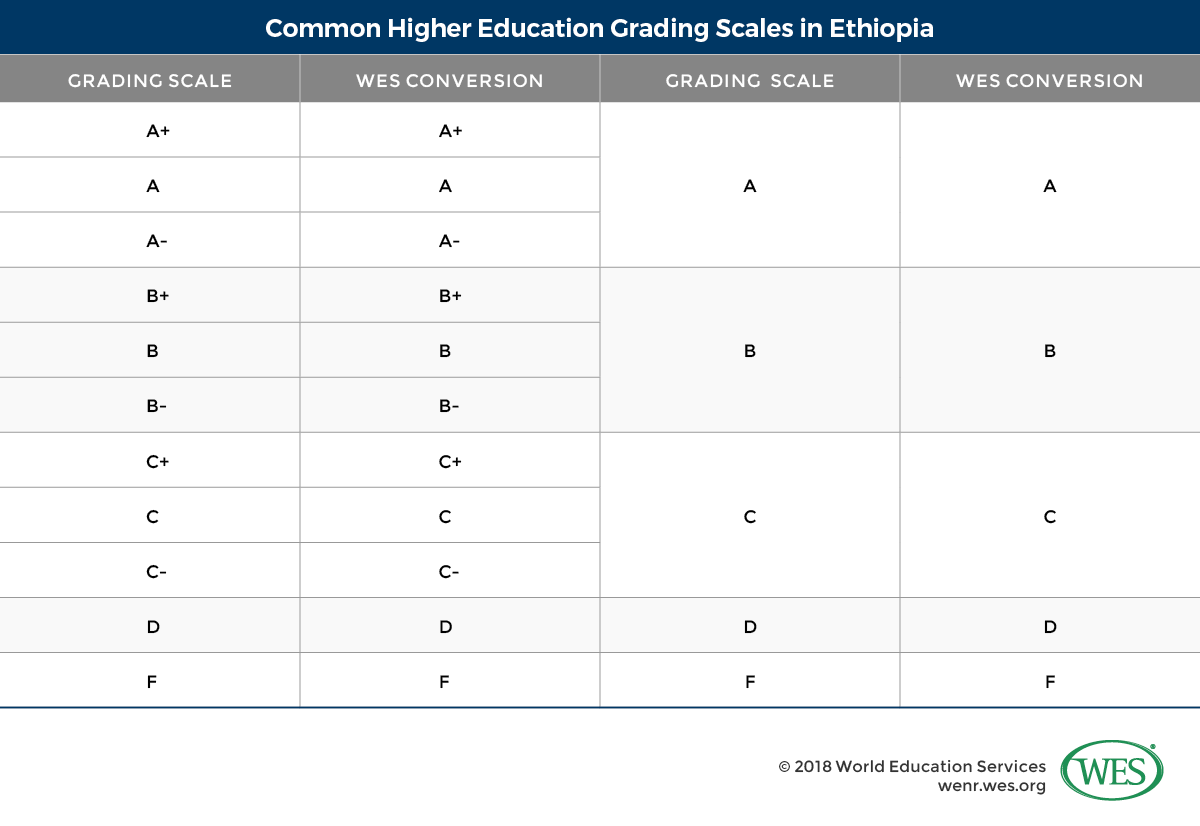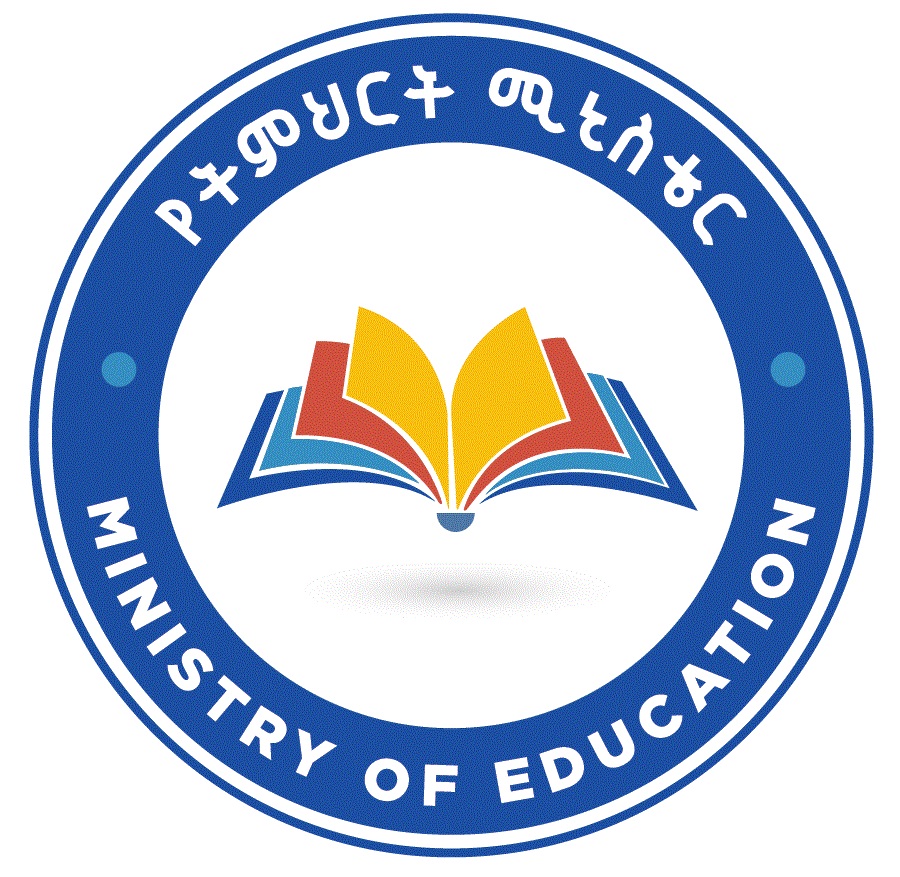Higher Education Credit System and Grading Scales
The credit systems and grading scales used by Ethiopian HEIs resemble those found in the U.S., although it should be noted that Addis Ababa University and several other universities recently began to use the European ECTS credit system. At most public universities, one credit unit is defined as one contact hour per week taken over a span of 16 weeks. The common minimum credit requirement in most four-year bachelor’s programs is 128 to 136 credits (16 or 17 credits or 30 ECTS per semester), whereas a three-year degree can be completed with a minimum of 102 to 108 credits (180 ECTS). Students who have earned a high enough GPA may be allowed to graduate in a shorter period of time by taking more credits per semester.
Grading scales resemble the standard U.S. A-F scale with some institutions using a simplified version without the “+” and “-” designations (see two common variations listed below). A minimum cumulative GPA of 2.0 (C) is usually required for graduation from bachelor’s programs, whereas master’s programs require a cumulative GPA of 3.0 (B).

The Tertiary Degree Structure
Ethiopia’s standard tertiary degree structure includes three- and four-year bachelor’s, master’s, and doctoral degrees. The overwhelming majority of Ethiopian students (about 95 percent) are enrolled in undergraduate programs: There were 729,028 undergraduate students in 2015 compared with only 37,152 students in master’s programs and 3,135 students in doctoral programs. Only 24 percent of graduate students were women. The most popular fields of study in undergraduate programs at public institutions were engineering and technology, business and economics, and the social sciences and humanities. At private institutions, more than 50 percent of students studied business and economics, followed by health sciences, engineering, and technology. At the graduate level, social sciences and humanities were the most popular disciplines overall.[1]
Diplomas
Until the 2000s, universities used to award two-year diplomas (12+2) and three-year advanced diplomas (12+3) in a variety of academic disciplines, such as history, biology, or engineering. Many of these diploma programs were part-time programs for students who didn’t quite meet degree admission requirements.
Today, diploma programs are more narrowly defined as TVET qualifications taught by TVET providers, so that these programs have been phased out at public universities, although some HEIs still offer applied diploma programs in fields like accounting or business administration. The old academic diploma programs, as well as some of the new TVET diplomas may be partially transferred into bachelor’s programs, depending on the program and institution.
Bachelor’s Degree
All bachelor’s degree programs in standard academic disciplines used to be four years in length and included a preparatory year designed to prepare students for higher education. However, in 2003 the preparatory year was eliminated and its content incorporated into upper-secondary curricula – preparing students for tertiary education is now a function of upper-secondary education.
Today, bachelor’s programs are three or four years in length and lead to the award of a Bachelor of Arts or Bachelor of Science, although other-named credentials like the Bachelor of Business may also be awarded by some institutions. The majority of current bachelor’s programs in social sciences, humanities, and business offered by Addis Ababa University are three years in length. Curricula are usually specialized with few, if any, general education requirements. Some programs may be studied in part-time (evening) or distance education mode over an extended time period of up to six years. These programs are typically referred to as extension programs and indicated as such on academic transcripts.
First degree programs in professional disciplines like engineering, law, architecture, pharmacy, medicine, or dentistry, on the other hand, are either five or six years in length and conclude with the award of credentials like the Bachelor of Laws, Bachelor of Pharmacy, or Doctor of Medicine (see also the section on medical education below).
Master’s Degree
Admissions standards for master’s programs are less strictly defined than undergraduate admissions criteria, and they are set by individual universities. That said, admission into master’s programs typically requires a bachelor’s degree in a related discipline with high enough grades and a passing score in a program-related entrance examination, as well as other aptitude tests and an English proficiency examination in some cases. Master’s degree programs commonly last two years (30–36 credits), although one-year, one-and-one-half-year, and three-year programs also exist. Most of them require the preparation of a thesis (or graduation project), but there are also non-thesis options, which have higher credit requirements. The standard credentials awarded are the Master of Arts and Master of Science.
Doctor of Philosophy
The Doctor of Philosophy is a terminal research degree that is earned after a minimum of three or four years of advanced graduate study. A master’s degree in a related discipline is the standard admission requirement, but in some programs students can also be admitted on the basis of a bachelor’s degree with high grades. Additional entry requirements may include entrance examinations, the submission of a research proposal, or English proficiency exams. Most programs include a course work component of two or more semesters and conclude with the defense of a dissertation written in English.
Medical Education
The standard entry-to-practice qualification in medicine, the Doctor of Medicine, is earned upon the completion of a long, single-tier undergraduate program of six-years’ duration. Medical curricula include a six-month pre-medical component (general sciences) and pre-clinical studies during the first two years, followed by three years of clinical studies, concluding with a qualifying examination. Students are required to complete a one-year clinical internship in the final year.
Ethiopia has a severe shortage of medical doctors, particularly in rural regions, and suffers from a high degree of out-migration of medical professionals. To stem this brain drain and expand health services throughout the country, all medical school graduates are currently mandated to register with the Ministry of Health of Ethiopia and work as general practitioners for two to four years before they can specialize. Certification in medical specialties requires another three to four years of clinical training at teaching hospitals, concluding with the award of a Certificate of Specialization or Specialist Diploma.
Ethiopia is currently expanding its medical training system. In 2012, 13 new medical schools opened in the country, boosting enrollments in medical programs to 3,100 students. Another reform designed to alleviate Ethiopia’s shortage of physicians is the New Innovative Medical Education Initiative (NIMEI). Adopted in 2012, NIMEI ushered in a shorter and revised 4.5-year medical curriculum intended for holders of bachelor’s degrees in health and natural sciences. These programs are offered by 10 universities and three teaching hospitals. To get admitted, applicants must pass a national medical entrance examination—a test that includes both written and oral components and is administered by the NEAEA.
Teacher Education
Ethiopia’s teacher training system is currently in flux with reforms being implemented at varying speeds in different parts of the system. Elementary schoolteachers are trained at 32 public teacher training colleges under federal supervision, as well as at private institutions. Admission is based on the EGSLCE (completion of grade 10). All teachers in elementary education are presently required to complete a three-year (10+3) training program and earn a diploma in elementary education. Until recently, it was possible to teach at the lower-elementary level (grades 1-4) upon earning a one-year (10+1) teaching certificate, but these programs are being phased out, and certificate holders are expected to upgrade their qualifications.
Secondary schoolteachers are required to hold at least a bachelor’s degree. Until lately, teachers earned a dedicated bachelor’s degree in education at universities and some teacher colleges, but the system is currently being changed to require teachers to complete a postgraduate teacher training program on top of a bachelor’s degree in another discipline. Since 2011, Postgraduate Diploma in Teaching programs have been created at several universities. They are one year in length and combine instruction in pedagogical subjects with a school-based internship. Institutions like Addis Ababa University also offer master’s degrees in education, and the government intends to make a master’s degree mandatory for upper-secondary teachers. However, Ethiopia is in dire need of teachers and faces enormous challenges in training enough qualified instructors. A substantial number of teachers in the country’s schools continues to teach without the required minimum academic qualifications.
